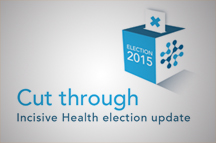 While the full Labour manifesto has been published today, the detailed health manifesto had its own launch on Saturday.
While the full Labour manifesto has been published today, the detailed health manifesto had its own launch on Saturday.
As Labour’s most comfortable policy territory, strategists may have hoped for a day of free hits and positive coverage. But Labour's carefully tailored messages on proposed improvements to midwifery services were immediately overshadowed by David Cameron’s pledge to meet Simon Stevens’ call for £8bn extra funding by 2020 (Mike Birtwistle examines the spending promise in greater detail in a new HSJ blog here).
Beyond the questions of money, Labour’s plan was largely a reiteration of existing policies: the 10-year plan for health and care, the public health strategy, and the mental health task force; all of which were published earlier this year.
Once again, core vote buttons are pushed: the introduction of a profit cap on private providers of clinical services; a nod to workforce demands, including increasing recruitment and using independent Pay Review Bodies to set pay; and the introduction of a preferred provider framework. New targets are proposed, including a guarantee on GP appointments within 48 hours and a maximum one-week wait for cancer tests. The NHS Constitution is also seen to be a key lever in driving up standards.
Overall, the language and tone reflects Burnham’s own five-year campaign to highlight the clear water between Labour and the Conservatives. The water between Labour and NHS England is somewhat muddier.
Despite the existence of a seemingly broad consensus around the vision of Simon Stevens’ Five Year Forward View, Labour’s manifesto does not name-check the document once. This may not be surprising; however well received, political parties rarely credit policy introduced on their opponent’s watch. But it does risk Labour’s health policy platform looking out of touch – fighting battles of 2012 rather than today.
Of course, the Stevens agenda is not wholly absent from Labour’s health manifesto. It recognises the need for the NHS to have the ‘freedom to collaborate, integrate and merge across organisational divides’. New, locally-driven ‘NHS integrated care organisations and networks’ will be supported, coupled with provider incentives for ‘prevention through year-of-care budgets’ – both of which fit very much within the Five Year Forward View model, as does the intention to improve access to new technology and information to empower patients.
But the water gets muddier around the issue of political accountability. Labour’s plan repeats their determination to restore ‘proper democratic accountability’ to the NHS. As a minimum, this will clip NHS England’s wings; at its most extreme the whole organisation could be brought back into the fold of the Department of Health.
Come the new Parliament, the possible tensions between an incoming Labour Government and the currently autonomous NHS leadership could well become more visible. With their promise of early primary legislation to repeal key elements of the Health and Social Care Act, the question of whether leadership of the NHS can be shifted without another major reorganisation is yet to be answered.
Mike Birtwistle highlights the health funding gamble that both main parties have taken this weekend as they try and overcome their perceived weaknesses in the eyes of the electorate.













